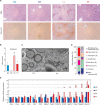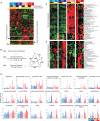Time-restricted feeding without reducing caloric intake prevents metabolic diseases in mice fed a high-fat diet
- PMID: 22608008
- PMCID: PMC3491655
- DOI: 10.1016/j.cmet.2012.04.019
Time-restricted feeding without reducing caloric intake prevents metabolic diseases in mice fed a high-fat diet
Abstract
While diet-induced obesity has been exclusively attributed to increased caloric intake from fat, animals fed a high-fat diet (HFD) ad libitum (ad lib) eat frequently throughout day and night, disrupting the normal feeding cycle. To test whether obesity and metabolic diseases result from HFD or disruption of metabolic cycles, we subjected mice to either ad lib or time-restricted feeding (tRF) of a HFD for 8 hr per day. Mice under tRF consume equivalent calories from HFD as those with ad lib access yet are protected against obesity, hyperinsulinemia, hepatic steatosis, and inflammation and have improved motor coordination. The tRF regimen improved CREB, mTOR, and AMPK pathway function and oscillations of the circadian clock and their target genes' expression. These changes in catabolic and anabolic pathways altered liver metabolome and improved nutrient utilization and energy expenditure. We demonstrate in mice that tRF regimen is a nonpharmacological strategy against obesity and associated diseases.
Copyright © 2012 Elsevier Inc. All rights reserved.
Figures







References
-
- Andreelli F, Foretz M, Knauf C, Cani PD, Perrin C, Iglesias MA, Pillot B, Bado A, Tronche F, Mithieux G, Vaulont S, Burcelin R, Viollet B. Liver adenosine monophosphate-activated kinase-alpha2 catalytic subunit is a key target for the control of hepatic glucose production by adiponectin and leptin but not insulin. Endocrinology. 2006;147:2432–2441. - PubMed
Publication types
MeSH terms
Substances
Grants and funding
LinkOut - more resources
Full Text Sources
Other Literature Sources
Medical
Miscellaneous

